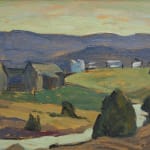
 Edwin Holgate
1892-1977
Edwin Holgate
1892-1977Morin Heights, c 1950
 Edwin Holgate
1892-1977
Edwin Holgate
1892-1977Morin Heights, c 1950
 Edwin Holgate
1892-1977
Edwin Holgate
1892-1977Morin Heights, c 1950
Edwin Holgate Canadian, 1892-1977
Further images
As an artist associated with the Beaver Hall Group and the Group of Seven, Holgate was celebrated for his depictions of the Canadian landscape. His style typically involved a blend of realism and modernism, with bold brushwork and a keen sense of composition.
In "Morin Heights, c.1950," Holgate captured the rugged beauty of the Laurentian Mountains, with their dense forests, rolling hills, and a tranquil stream. The painting conveys a sense of serenity and tranquility, inviting viewers to immerse themselves in the natural splendor of the Quebec countryside.
Given the title's reference to the 1950s, the painting likely provides insight into the post-war era, offering a glimpse into a period of change and transformation in Canadian society. Through "Morin Heights, c.1950," viewers are likely transported to the heart of the Laurentians, where they can appreciate the timeless beauty and tranquility of this iconic Canadian landscape.


